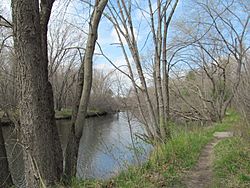Oxbow National Wildlife Refuge facts for kids
Quick facts for kids Oxbow National Wildlife Refuge |
|
|---|---|
|
IUCN Category IV (Habitat/Species Management Area)
|
|

Nashua River
|
|
| Location | Middlesex County, Worcester County, Massachusetts, United States |
| Nearest city | Harvard, Massachusetts |
| Area | 1,667 acres (6.75 km2) |
| Established | 1974 |
| Governing body | U.S. Fish and Wildlife Service |
| Website | Oxbow National Wildlife Refuge |
The Oxbow National Wildlife Refuge is a special natural area in Massachusetts, United States. It's part of the National Wildlife Refuge (NWR) system, which protects important lands for wildlife. This refuge was created in 1974. It covers parts of both Middlesex and Worcester counties.
Contents
What is the Oxbow National Wildlife Refuge?
The Oxbow National Wildlife Refuge is located in central Massachusetts. It's about 35 miles (56 km) northwest of the big city of Boston. The refuge stretches across four towns: Ayer, Shirley, Harvard, and Lancaster.
This special area is about 1,667 acres (6.75 km2) big. It includes different types of land. You can find upland areas, forests that grow on floodplains (flat land near rivers), and wetlands. These different habitats are found along nearly 8 miles (13 km) of the Nashua River.
How the Refuge Was Created
The Oxbow National Wildlife Refuge was formed over time. Most of its land came from the U.S. Army's Fort Devens military base.
- In May 1974 and February 1988, the Army transferred about 711-acre (2.88 km2) of land. This formed the first part of the refuge, south of Massachusetts Route 2.
- Then, in May 1999, another 836-acre (3.38 km2) was added from the Army. This part is north of Route 2.
- Finally, in April 2001, about 120 acres (0.49 km2) of private land was bought. This land, known as the former Watt Farm, added to the refuge in Harvard.
Wildlife and Habitats at Oxbow
The main reason the Oxbow National Wildlife Refuge was created is to help protect migratory birds. These are birds that travel long distances between their breeding and wintering grounds. The refuge helps with the national program to manage these birds.
Diverse Animals and Plants
The refuge has a mix of different habitats. There are wetlands, forests on higher ground, and old fields. This variety makes it a perfect home for many kinds of animals.
You can find a wide range of migratory birds here. These include:
- Waterfowl: Birds like ducks and geese.
- Wading birds: Birds with long legs, like herons.
- Raptors: Birds of prey, such as hawks and owls.
- Shorebirds: Birds that live near water, like sandpipers.
- Passerines: Songbirds, like sparrows and warblers.
Besides birds, the refuge is also home to many other animals that live there all year. These include:
- Mammals (like deer and foxes)
- Reptiles (like snakes and turtles)
- Amphibians (like frogs and salamanders)
- Fish
- Invertebrates (like insects and spiders)
The wetlands in and around the Oxbow Refuge are very important. They are recognized as a top priority for protection. This is because they are vital for many different species.
Special Protected Areas
Parts of the Oxbow National Wildlife Refuge are within even larger protected areas.
- The southern part of the refuge is inside the Central Nashua River Valley Area of Critical Environmental Concern (ACEC). This area is about 12,900 acres.
- The northern parts of the refuge are in the Squannassit ACEC.
These ACECs are special because they have unique environmental features and are very valuable for wildlife.
Friends of the Refuge
The Oxbow National Wildlife Refuge has a group of dedicated volunteers called The Friends of the Oxbow National Wildlife Refuge. This group is very active. They help share information about what the U.S. Fish & Wildlife Service is doing at the refuge. They also organize their own activities for people to enjoy in and around the refuge.


